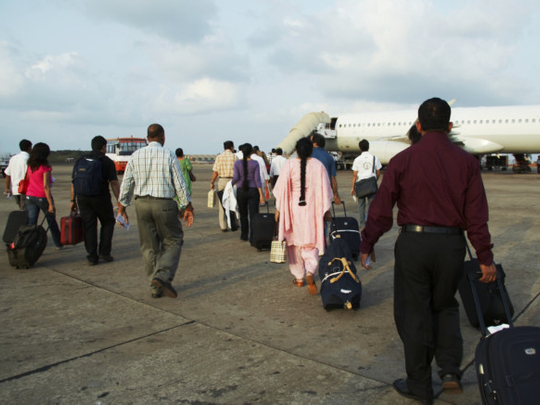
When for the first time ever a foreign carrier, Emirates, claimed the highest market share for traffic to/from India in the financial year 2012-13, the question everyone asked was — what took it so long? Last September, with the government’s announcement allowing foreign airlines to pick up to a 49 per cent stake in Indian carriers, the chaos in the Indian aviation sector at both the policy and practice levels was set in some sort of order.
The International Air Transport Association (IATA) expects traffic at Indian airports to reach 450 million by 2020, making it the third-largest aviation market in the world, with some 90 million passing through Delhi alone each year.
A key factor that has activated a flurry of optimism in the market has been interest by foreign players with a good track record, such as AirAsia and Etihad Airways. In one example, the Indian carrier SpiceJet saw its shares surge 8.1 per cent in July, despite denying news reports that Gulf airline Kuwait Airways was interested in taking a nearly 25 per cent stake in the budget airline.
But this optimism is tinged with its own set of problems. A fitting example is the $379 million (about Dh1.4 billion) Jet-Etihad deal announced in April, when Abu Dhabi-based Etihad announced its decision to purchase a 24 per cent stake in Jet with additional equity investments. Along the way, Etihad must leap several regulatory hurdles, including approvals by the Foreign Investment Promotion Board, capital market regulator Securities and Exchange Board of India, fair trade watchdog Competition Commission of India, the Department of Industrial Policy and Promotion and the Union Cabinet Committee on Economic Affairs.
Saj Ahmad, chief analyst at StrategicAeroResearch.com, puts the bureaucratic red tape in perspective. He tells GN Focus: “India is far from maturity in any aspect of aviation growth, policy or execution. One only need look at the shambles that the Jet-Etihad deal has become for evidence of that.”
Trouble on the home front
India’s airlines have struggled with profits. Aviation advisory, the Centre for Asia-Pacific Aviation (CAPA), estimates that India’s airlines posted a combined loss of $1.15 billion in the financial year 2013 — even after excluding performance by Kingfisher Airlines, grounded since late last year. Even though the losses were down from about $2.28 billion the previous year, the 2013-14 edition of the annual CAPA India Aviation Outlook Report says: “Continued losses and the further erosion of net worth may widen the gap between promoter and investor expectations when it comes to valuations. Combined with the prospect of new entrants into the market, this might impact capital raising plans for incumbent carriers.”
Ahmad says that Indian aviation is not fulfilling its potential. “Even the low-cost airlines are not appealing since none of them have really truly broken out of India to grow the way flydubai or Air Arabia have — and these are airlines whose home markets are tiny,” he says.
Favourable dynamics
However, the sector is still reaching for the skies. Even Kingfisher’s recent exit worked in favour of the industry. The CAPA report says: “As a result of the removal of Kingfisher’s seats, combined with modest capacity induction by other carriers, the demand/supply dynamics in the market started to favour airlines for the first time since 2004. This was reflected positively in the average fares, which increased by 15-20 per cent year-on-year.”
The sector has also become a priority at the highest levels. Earlier this year, Prime Minister Manmohan Singh spoke about the strategic nature of civil aircraft manufacturing at a meeting of the High Level Committee on Manufacturing, pledging $2 billion for the development of a 70-to-90-seat civilian aircraft. In February, Tony Fernandes’s Malaysian low-cost airline, AirAsia India, entered the fray, investing $30 million to begin with, in partnership with Tata Sons, the company that gave India its first airline.
The prospect of international companies entering the market is promising, says Vinit Phatak, Chairman, Invision Group, and co-founder of Invision Air, a business aviation company with a vision to kick-start the executive charter sector. “It provides more exposure to India’s potential. These announcements work as advertisements for the sector,” he says.
The Civil Aviation Minister, Ajit Singh, said in May that the government envisages an investment of $12.1 billion in the airport sector during the 12th plan period. Later that month, the Minister of State for Civil Aviation, KC Venugopal, informed parliamentarians that out of 15 greenfield airports that the government had approved in principle, work has already begun at six.
Ajit Singh also announced that the national carrier Air India would get another eight Dreamliners by December this year, taking the total number of B-787 Dreamliner aircrafts with Air India to 14. The airline has also accepted cost-cutting recommendations, expecting a saving of about Rs5 billion (about Dh298 million) in six months.
In July the government deferred a decision on increasing the cap on foreign direct investment in civil aviation from 49 per cent to 74 per cent since “there were no interested parties waiting in the wings.”
The shot in the arm needs to come from a structured framework and long-term vision for the sector. According to CAPA, “a massive upheaval is occurring in Indian aviation. Yet, despite this, there has been no change in the nation’s approach to policy and regulation. The result is a disconnected and ultimately costly jumble of adjustments.”
But the CAPA report sums it best: “Nevertheless, we believe that there is sufficient confidence in the long-term fundamentals of the market to maintain investor interest and we expect a further two Indian carriers to complete transactions with strategic or financial partners in FY14.”
Things are definitely on an upward flight path.







